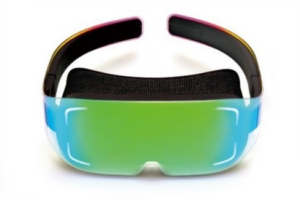Sharp presented a virtual reality head mounted display (HMD) at the recent CES. The HMD was a prototype and intended for use in conjunction with a smartphone. At the CES show, the HMD was connected to a Sharp Aquos R7 Android smartphone via USB-C. Major features claimed for the new HMD are that it is especially compact and lightweight.
A brief video attached to the end of this article presents the prototype virtual reality HMD. The figure below is an illustration of the HMD.

The HMD weighs in at a very lite 175 grams. Part of the reason for the compactness is an in-house developed ultra-thin pancake type eyepiece. (Note: Pancake lenses use polarizers, waveplates and reflective surfaces to fold the optical path through two glass or plastic lens elements, reducing the distance between the display and lens.) Other features and specifications of the HMD include the following:
- LCD display resolution is 4K (2K per eye).
- 120 Hz refresh rate.
- Diopter correction can be attached to the lenses.
- The HMD does not have an inter pupillary distance adjustment.
- Speakers are integrated into the arms of the HMD.
- The HMD can be folded into a more compact form.
The prototype includes a built-in RGB color camera module. The camera module provides ultra-fast focusing through the use of a polymer lens. Image focusing is achieved by electronically altering the thickness of the polymer lens. (Note: the polymer lens in the Sharp HMD is believed to be the so-called TLens developed by poLight ASA of Horten, Norway).
The HMD also has a pop-up function that displays imagery of the surrounding real world in a separate window on a section of the virtual reality space. The company explains that, “even when the position of the focus moves, the angle of view (the range that can be seen) remains the same, reducing motion sickness.”
The HMD includes two black and white cameras to support hand tracking. The cameras can be used to enable conversion of hand movements into operations in the visible field. By this means, it becomes possible to operate the HMD without controllers. The press release provided by Sharp in conjunction for the CES demo does not explicitly mention if the cameras can also enable room tracking. None-the-less, this function seems reasonable. Reportedly, the HMD supports 6 DOF tracking.
Some on-line reports state that the HMD has the capability to capture objects photogrammetrically and bring them into the virtual reality space as a 3D model. (Note: Part of a general definition of photogrammetry is that it is: the science and technology of obtaining information about physical objects and the environment through the process of recording, measuring and interpreting photographic images. One specific example of photogrammetry is: the extraction of three dimensional measurements from two dimensional data.)
Many details related to Sharp’s prototype HMD are still unavailable. Clearly the HMD is not yet in the form of a finished product. It is less clear if and when the prototype will evolve into a commercial product. In fact, some on-line analysis have suggested that Sharp is more likely to be using the HMD as a means to showcase the built-in technologies (the RGB polymer lens based camera, the thin liquid crystal display and the pancake lens) so as to position the company as a component supplier to designers and manufacturers of HMDs.

